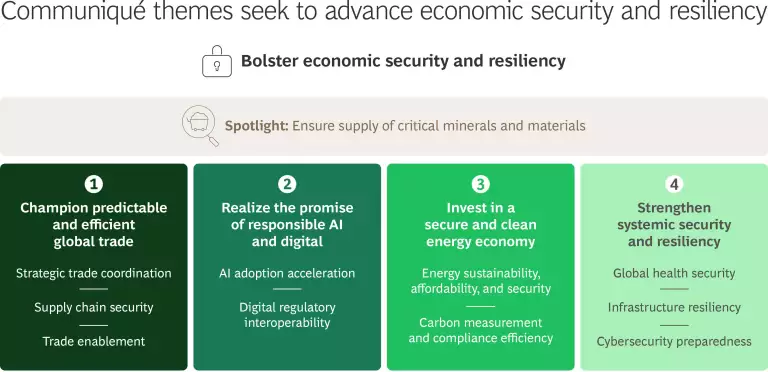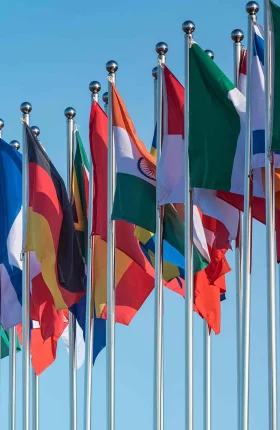The global international order is experiencing a period of extraordinary disruption and uncertainty. As broad trade protectionism rises, global coordination is diminishing, just as it is most needed both to confront increasingly complex challenges and to harness emerging opportunities to unlock new sources of growth.
Since the 1970s, the G7—Canada, France, Germany, Italy, Japan, the United Kingdom, the United States, and the European Union—has served as a cornerstone of global cooperation and progress. It has fostered an era of unprecedented stability and economic prosperity that has enabled businesses to grow, innovation to thrive, and standards of living to rise.
Today, the very system the G7 helped build is under strain, as global power dynamics shift to a less cooperative, multipolar model. Despite these headwinds, the G7 remains uniquely positioned to uphold and enhance global institutional capacity to deliver on foundational commitments—efforts that are core to the G7 mission of fostering shared prosperity and resilient economic growth.
“The current climate of unprecedented economic uncertainty threatens the prosperity and security of the G7 and emboldens our geopolitical competitors that are increasingly seeking to exploit our vulnerabilities to reshape the international order,” Candace Laing, president and CEO of the Canadian Chamber of Commerce, wrote in a foreword to this year’s B7 Communiqué, which represents the G7 business community’s recommendations to the G7 ahead of their annual summit.
The Business Federations of the Group of Seven, or B7, represents the interests of the business community in the G7 countries and provides policy recommendations for G7 leaders. BCG has a rich track record supporting global business forums and is the official knowledge partner of the 2025 B7. In this role, BCG has played a key part in supporting the development of the B7 Communiqué, providing thought partnership, sharing the latest research and insights across a wide range of topics, and contributing deep global experience and expertise.
The 2025 B7 Communiqué provides a strategic blueprint for G7 leaders both to address today’s most pressing economic challenges and to build more secure economic linkages. The Communiqué centers on the theme of economic security and its intersection with trade, AI, and energy. It also spotlights the importance of critical minerals and materials, and their essential role in safeguarding economic and national security.

Critical Minerals: High Demand and Short Supply
The secure supply of critical minerals is a particular challenge for the G7, given their role as essential inputs in goods and components such as batteries, solar panels, electric vehicles, and fertilizer. Access to minerals, such as lithium, cobalt, nickel, rare earth metals, and copper, is a growing concern, as global competition shapes control, supply, and development of essential resources.
Demand for certain minerals is expected to surge by up to 800% by 2040. China, a concentrated source for rare earth metals, is actively consolidating its lead in critical minerals supply chains. Excess supply from China has contributed to market imbalances, putting pressure on prices and complicating the investment environment for private companies. This level of reliance on a single country also increases G7 members’ exposure to potential supply disruptions, with implications for national security and economic resilience.
Predictability and Efficiency Needed for Seamless Global Trade
The political consensus around free trade and open markets has been challenged recently as countries look to advance domestic economic and national security interests and, as a result, have taken uniliteral trade actions that are inconsistent with long-established, shared rules. Non-market practices, such as discriminatory actions or subsidies; trade protectionism, including extraordinary tariffs and other unilateral trade actions; as well as a breakdown in dispute settlement mechanisms are all contributing to uncertainty and weakening global relationships. However, BCG analysis shows that a more predictable, globalized trading system could result in potential economic gains of $8.5 trillion across the G7.
At the same time, supply chain networks face increasing threats from protectionism, wars, extreme weather events, pandemics, and more. The OECD (Organization for Economic Cooperation and Development) estimates that just 30% of international trade is finished goods, while the remaining 70% is from intermediate steps in global supply chains. As a result, persistent disruptions in critical industries could lead to shortages, with potentially devastating economic consequences.
And while governments work to bring some stability to global trade activity, there is also a need to invest in digital infrastructure, to advance regulatory cooperation on trade, and to expand access to trade finance—particularly for MSMEs (Micro, Small, and Medium Enterprises)—to promote efficiency and keep pace with technological advancements.
Stay ahead with BCG insights on international business
AI Brings Tremendous Opportunities, but Also Risks
The acceleration of AI adoption presents a transformative opportunity, with estimates indicating that it could increase global GDP by as much as $7 trillion worldwide by 2030, assuming advancements in productivity are met with gains in aggregate demand.
While G7 countries have led in the development of generative AI, enterprise-level adoption in these countries is at risk of falling behind global peers. The recent announcement of China’s DeepSeek AI technology highlights the intensifying competition for global leadership in AI development.
Three particularly critical challenges are talent shortages, infrastructure constraints (such as energy infrastructure to support the massive increase in data center computing demand), and regulatory uncertainty.
Creating internationally agreed upon approaches and standards for both AI and cross-border data flows is a critical dimension of the looming digital transformation that will, like AI adoption, require G7 coordination.
Collaboration and Investment Required to Create Secure, Affordable, and Sustainable Energy
Worldwide energy demand is projected to rise by nearly 50% by 2050, driven by industrial expansion and population increases.
Despite global agreements to meet lower greenhouse gas emissions targets, the world is far off-track from attaining agreed-upon goals. Clean energy is projected to meet only 40% of global energy demand by 2050, well below the 90% required to achieve net zero emissions.
The scale of investment required to bridge the gap is substantial. Meeting solar and wind deployment targets alone could require $41 trillion to $57 trillion by 2050, according to BCG estimates, with an additional $18 trillion needed for energy and industrial infrastructure by 2030.
An important dimension to help meet stated emissions targets involves aligning shared accounting principles for carbon prices on both the corporate and product levels to smooth price imbalances and enable cross-border market adjustments to function seamlessly.
In this context, liquid natural gas (LNG) offers a transitional opportunity. As a low-emission traditional fuel source with supply in G7 countries, including Canada, LNG can play a strategic role in supporting global energy security and grid reliability.
Systemic Enablers Drive Prosperity and Stability
Health, infrastructure, and cybersecurity are the invisible scaffolding of modern economies, systemic enablers of resilience that underpin global economic activity and social trust. In an era of escalating shocks and interdependence, weaknesses in any one of these pillars reverberate across borders and sectors, making coordinated, future-focused investment across all three an urgent imperative for long-term economic security.
The global health system stands at a tipping point. Funding constraints, capacity shortfalls, and the growing dual burden of infectious and chronic disease threaten decades of progress. Climate-linked health risks, aging populations, and system fragility could cost trillions in lost productivity. Innovation—ranging from diagnostics to digital health—offers a powerful path forward, but only if equitably deployed. Led by the private sector and underpinned by years of public research, the swift development of COVID-19 vaccines illustrates the power of a pro-innovation environment—a framework that could be key to addressing growing challenges such as antimicrobial resistance, and has the potential to cut global GDP by 1.1%–3.8% by 2050. Revisiting global health architecture, scaling surveillance and emergency preparedness, and ensuring innovation works for all are pathways toward a more resilient and responsive health system.
Infrastructure, meanwhile, is faltering under the weight of chronic underinvestment, aging assets, and increasingly destructive weather events. These stresses risk triggering cascading failures across critical systems and global trade routes, including in LMICs (Low- and Middle-Income Countries) where investment gaps are acute but not easily overcome. With a $15 trillion shortfall looming by 2040, the case for resilient infrastructure is both urgent and economically compelling. Coordinated public and private sector action can close this gap while unlocking high-impact returns.
Similarly, cyberspace has emerged as both a key enabler of and vulnerability for economies, with systems that affect everyday life from hospitals to power grids. As cybercrime grows more complex and costly—set to top $2 trillion by the end of 2025—businesses struggle with regulatory fragmentation, talent shortages, and the pace of emerging threats. By investing in skills, collaboration, and innovation, digital trust can be safeguarded to ensure that security keeps pace with connectivity.






